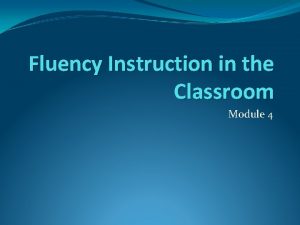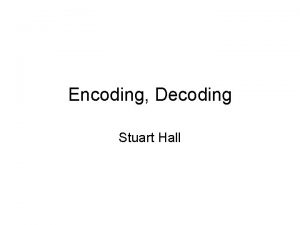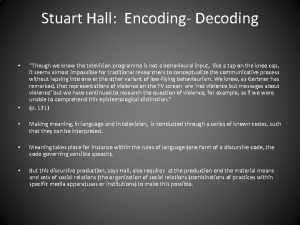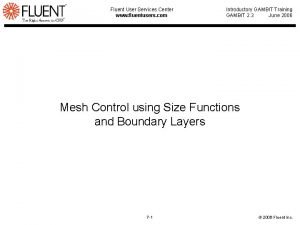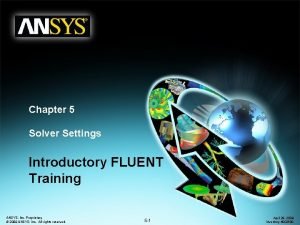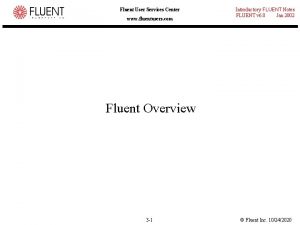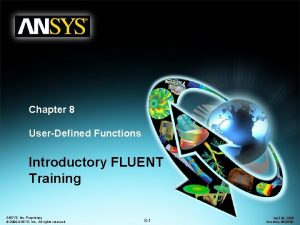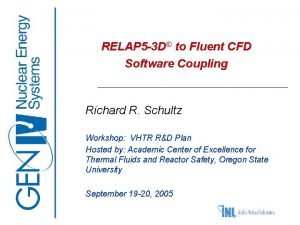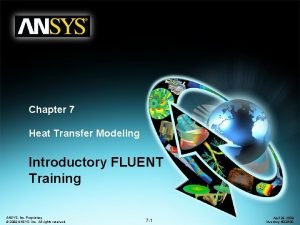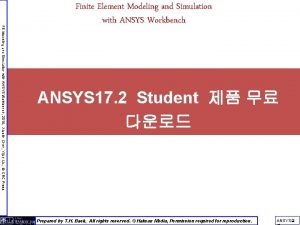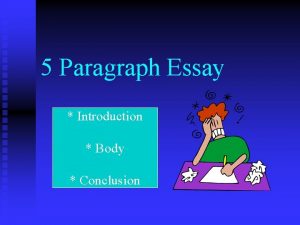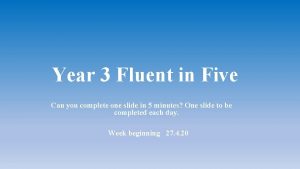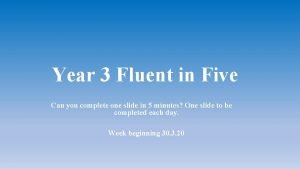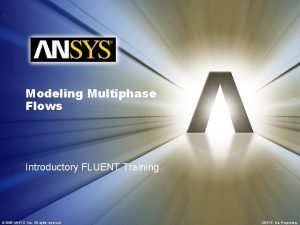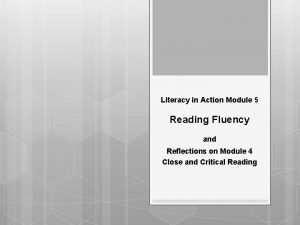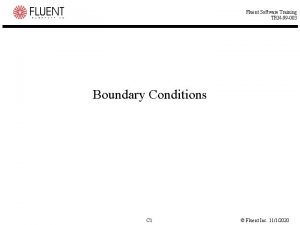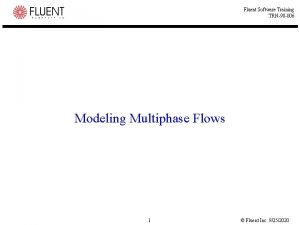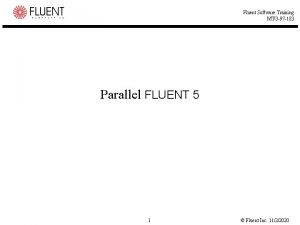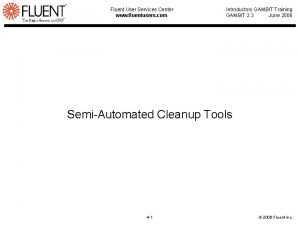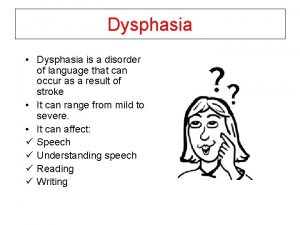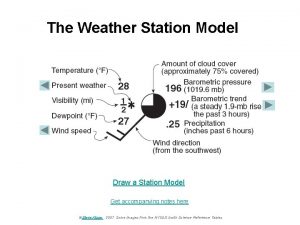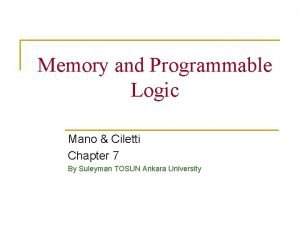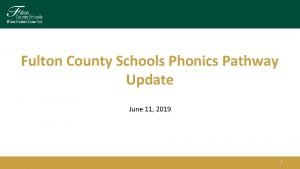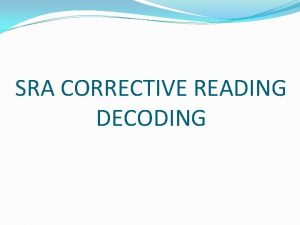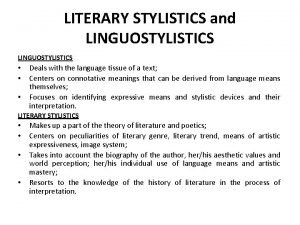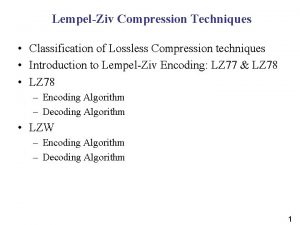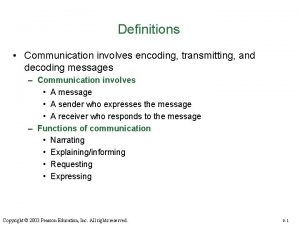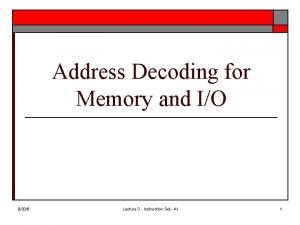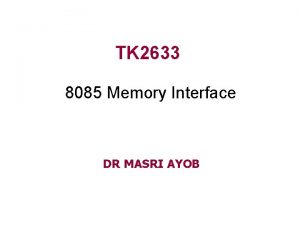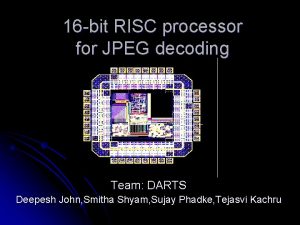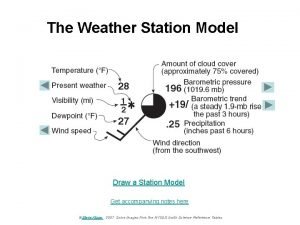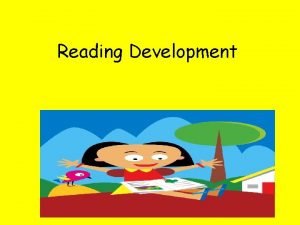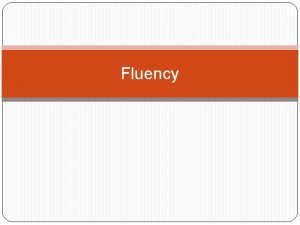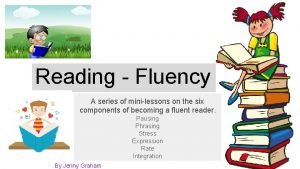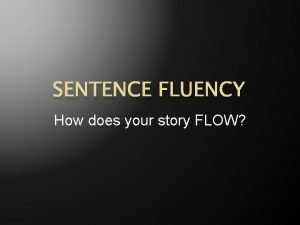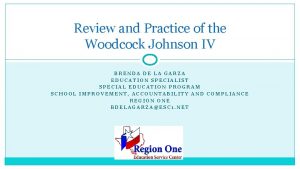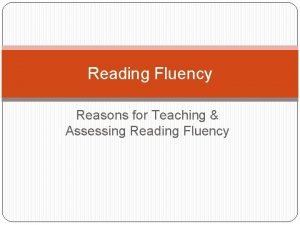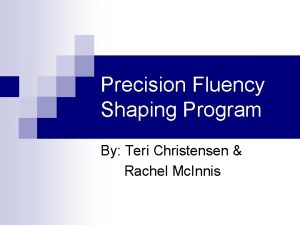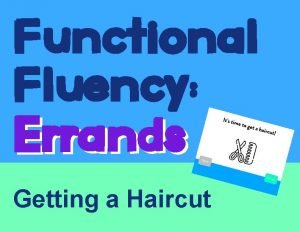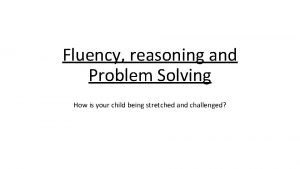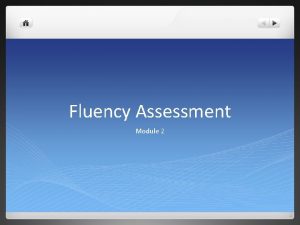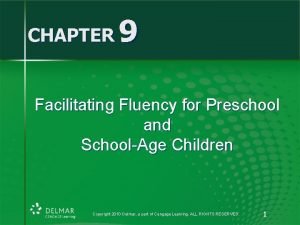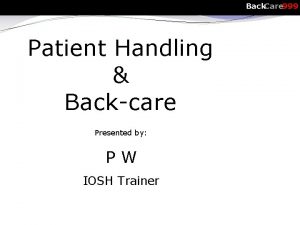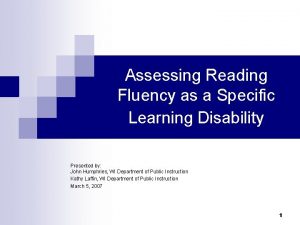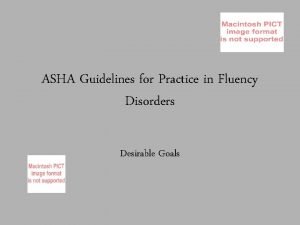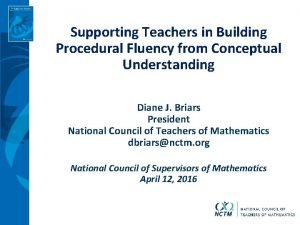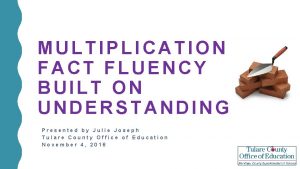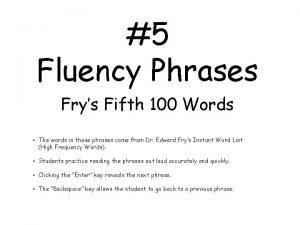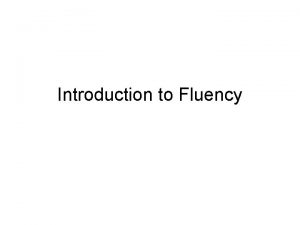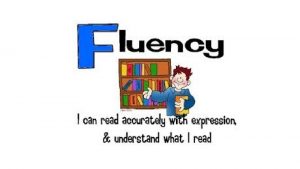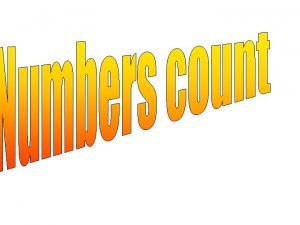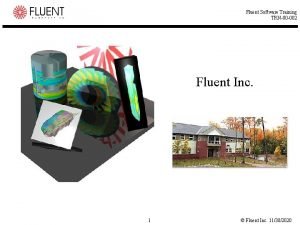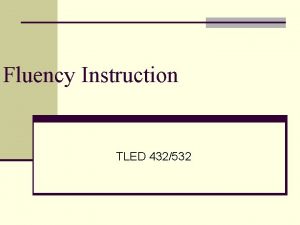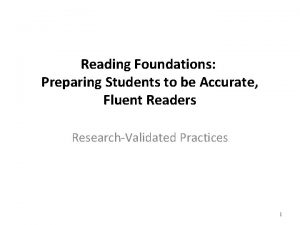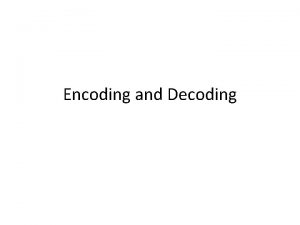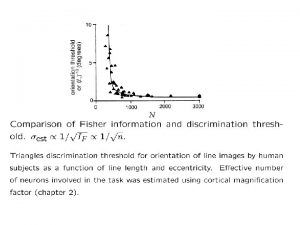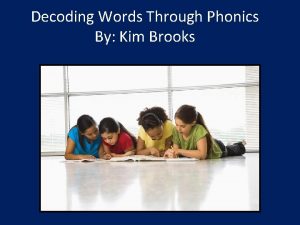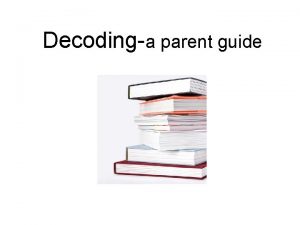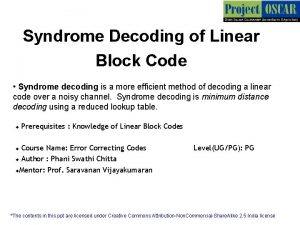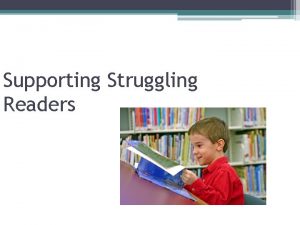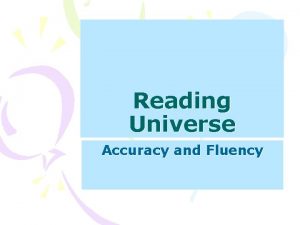Decoding and Fluency Instruction Ensuring Accurate and Fluent







































































- Slides: 71

Decoding and Fluency Instruction: Ensuring Accurate and Fluent Reading Evidence-Based: Practices 1

Anita L. Archer, Ph. D. Author and Consultant archerteach@aol. com 2

Critical Elements n n n Phonemic Awareness Decoding Fluency Vocabulary Comprehension And n n n Oral Language Background Knowledge Writing 3

Critical Elements Phonemic Awareness n Decoding n Fluency n What Why How 4

Phonological Awareness What? n Understanding that oral language can be broken into components. √ √ n Sentences into words Words into syllables Words into on-set rimes Words into phonemes Involves: √ Blending √ Segmenting 5

Phonological Awareness - What Blending Segmenting Sentences into words “Listen. I - rode - the - bus. “Listen to this sentence. Say the sentence. ” We ate lunch. Clap and say the words in the I rode the bus. sentence. ” We - ate lunch. Words into syllables “Listen to the parts of a word. rock - et Say the word. ” rocket “Listen. Marty Let’s clap and say the parts in Marty. ” Mar -- ty Words into onset rimes “Listen. f -- at What word? ” fat “Say Sam in two parts. ” S --- am Words into phonemes “Listen. I will say the sounds. You say the word. mmmmaaaat What word? ” mat “Fist in the air. Say the sounds in man and put up one finger for each sound? ” mmm aaa nnn 6

Phonemic Awareness What? n n n The ability to hear and manipulate phonemes (sounds) within words. An auditory skill. Segmenting and blending activities have the greatest benefit to reading acquisition. (National Reading Panel, 2000; Snider, 1995) n Generally, teach blending before segmenting. (Lane & Pullen, 2005) 7

Phonemic Awareness Why? n n n Must be aware of phonemes within words in order to map graphemes onto phonemes. (Ehri & Roberts, 2006) Phoneme awareness performance is a strong predictor of long-term reading and spelling success and can predict literacy performance more accurately than variables such as intelligence, vocabulary knowledge, and socioeconomic status. (Gillon, 2004) Phonemic awareness activities in kindergarten resulted in word reading gains in first and second grade. (Foorman, Francis, Beller, Winikates, & Fletcher, 1997) 8

Phonemic Awareness - Why n n Phonemic Awareness can help students learn to read and spell. The relationship between phonemic awareness and learning to read and spell is reciprocal: having phonemic awareness helps children learn to read and spell; learning to read and spell words by working with letter-sound relationships improves children’s phonemic awareness. 9

Phonemic Awareness How? n n n Include phonemic awareness activities in beginning reading programs for students of any age. Kindergarten: 10 - 15 minutes a day (Foorman et al, 1997) First Grade: (First three months) 10 minutes a day incorporated into phonics instruction Intervention: Within intervention program if student reads below 2 nd grade level All Elementary Grades: Incorporate into spelling instruction. 10

Phonemic Awareness How? n Phonemic awareness activities should be: 1. Few in number. 2. Explicitly modeled. At-risk students need additional explicit instruction. 3. Supported by concrete materials or gestures. 4. Designed to include all students. 11

Example A n Blending Sounds into Words 1. We’re going to play a say-the-word game. I’ll say the sounds. You say the word. 2. Listen. aaaammmmm 3. What word? am 4. (Repeat with other words. ) 5. (If time permits, check individual students. ) (Practice: man, sat, ship, trap) 12

Example B n Segmenting words into sounds Smooth Segmenting 1. Put your fists together. 2. Get ready to stretch the word. 3. The word is fin. What word? fin 4. Stretch it. fffiiiiinnnn 5. Shrink it. fin 6. (If time permits, check individual students. ) (Practice: sit, list, fish, trip) 13

Example C n Segmenting Words into Sounds Separate Segmenting 1. 2. 3. 4. We’re going to say the sounds in a word. Fist in the air. Put up one finger for each sound. The word is sat. What word? sat First sound? /sss/ Next sound? /aaa/ Last sound? /t/ 5. (If time permits, check individual students. ) (Practice: fan, fast, shop, with) 14

Decoding - What? n The ability to utilize letter- sound (phoneme-grapheme) associations and structural elements to determine the pronunciation. 15

Decoding - What? n Letter-sound associations √ Consonant and vowel letters √ Consonant combinations including: - blends - digraphs √ Vowel combinations including: - digraphs - diphthongs - r-controlled vowels n Decoding of regular, single syllable words 16

Decoding - What? n n Structural elements including: √ Inflectional endings √ Prefixes √ Suffixes Decoding of multisyllabic words Reading of irregular words in which letters don’t represent most common sounds Reading decodable text 17

Decoding Instruction progression 1. 2. 3. 4. 5. Associating letters and sounds. Blending sounds into words. Reading words to build fluency (accuracy and rate). Segmenting and spelling words. Reading decodable text. 18

Letter-Sound Associations Why? n English is an alphabetic language. n Students with letter-sound associations perform better. (Juel, 1991) n Students benefit from early, systematic introduction to letter-sound associations. “Phonics instruction provides the biggest impact on growth when begun in kindergarten or first grade before children have learned to read independently. ” (National Reading Panel, 2000) n Good readers rely primarily on the letters in a word rather than context or pictures to identify/pronounce familiar and unfamiliar words. (Ehri, 1994) 19

Letter-Sound Associations Why? n Reexamining the THREE CUEING SYSTEMS √ Primary System Phonological cueing system (Letter-sound associations) √ Confirmation Systems Syntactical cueing system (Word-order) Semantic cueing system (Contextual meaning) 20

Letter-Sound Associations How? n Utilize a well-organized, systematic sequence to introduce the most common letter-sound associations. n n Easy to difficult. (Example: single vowel letters before digraphs) High frequency before low frequency letter-sound associations. (Example: m, a, f BEFORE j, x and z) n Separate easily confused letter-sound associations. (Example: e and i, n and m, b and d) n n Provide explicit instruction (rather than implicit instruction) to introduce letter-sound associations. Differentiate between continuous and stop sounds. Continuous Sounds Stop Sounds - 21

Letter-Sound Associations How n Teach letter-sound associations to a high level of mastery. n Provide cumulative review. n Brief Introduction - Eternal Review 22

Example Teaching Letter-Sound Associations sat 1. (Point to example word. ) This word is sat. 2. (Point to the underlined grapheme. ) This sound is /aaaa/. 3. What sound? /aaaa/ OR a 1. (Point to the isolated grapheme. ) This sound is /aaaa/. 2. Say the sound with me. /aaaa/ 3. What sound? /aaaa/ 23

Decoding of regular words Why? n Decoding is necessary though not sufficient for comprehension. “There is no comprehension strategy powerful enough to compensate for the fact you can’t read the words. ” (Archer, 2008) n n Ability to blend individual sounds into recognizable words is a critical component of reading. (Beck, 2006) Diverse learners must be encouraged to look carefully at spelling and sounds and to repeatedly sound out and blend words. (Reitsma, 1983) 24

Decoding of regular words Why? n n That direct instruction in alphabet coding facilitates early reading acquisition is one of the most well established conclusions in all of behavioral science. (Stanovich, 1994) “Systematic phonics instruction produced significantly greater growth than non-phonics instruction in younger children’s reading comprehension. ” (National Reading Panel, 2000) 25

Decoding of regular words Why? n First graders’ decoding ability continues to be a major factor in comprehension as students progress through the grades. (The Connecticut Longitudinal Study) n Poorly developed word recognition skills are the most pervasive and debilitating source of reading challenges. (Adams, 1990; Perfetti, 1985; Share & Stanowich, 1995) n The ability to decode long words increases the qualitative differences between good and poor readers. (Perfettti, 1986) 26

Decoding of Regular Words - How? n n As soon as a sound is learned, incorporate the sound into words. Model blending of sounds into words. Provide an adequate amount of practice on decoding words to build word fluency. Preteach difficult to pronounce words before passage reading. 27

Decoding Strategy for Short Words 1. 2. 3. 4. Say the sounds fast. Say the word. Ask yourself Is it a real word? Does it make sense? 28

Example A - Sound by Sound Blending Sounding Out VC, CVCC, CCVC words mom top shop dot 1. (Write the first letter on the board. ) What sound? 2. (Write the second letter on the board. ) What sound? 3. (Move your hand under the two letters. ) Blend it. 4. (Write third letter. ) What sound? 5. (Move your hand under the letters. ) Blend the sounds. 6. What word? 29

Example B - Continuous Blending (Modeling) Sounding Out VC, CVCC, CCVC words sip fit lip tip rim 1. When I touch a letter, I’ll say its sound. I’ll keep saying the sound until I touch the next letter. I won’t stop between sounds. 2. My turn to sound out this word. (Touch under each letter and say the sound. Hold continuous sounds. Say stop sounds quickly. Don’t stop between sounds. ) 3. Sound out this word with me. (Touch under each letter. ) 4. Your turn. Sound out this word by yourselves. (Touch under each letter. ) 5. What word? (Glide your finger under the word. ) 30

Example B - Continuous Blending (Guided Practice) Sounding Out VC, CVCC, CCVC words 1. When I touch a letter, say its sound. Keep saying the sound until I touch the next letter. Don’t stop between sounds. (Touch under each letter. ) 2. What word? (Glide your finger under the word. ) 31

Example C Sounding Out Words with Letter Combinations rain train paint sail seal Precorrection Procedure 1. 2. 3. 4. What sound? What word? (Point to the underlined letters. ) (Point to the word. ) (Have students reread the list without the precorrection. ) (Have individual students read the words or have them read the words to their partner. ) 32

Example D CVCE words using rule Decoding CVCE words bake rat brake man 1. An e at the end of a word tells us to say the name of this letter. (Point to the vowel letter. ) 2. (Guide students in applying the rule. ) a. Is there an e at the end of this word? b. (Point to the vowel letter. ) So do we say the name or the sound of this letter? c. What is the name of this letter? d. (Point to the word. ) What word? 33

Example D - CVCE words Sound Blending like mine fit fine 1. 2. 3. 4. 5. (Point to the first letter. ) What sound? (Point to the vowel and final e. ) What sound? (Point to the consonant. ) What sound? (Glide finger under the word. ) Blend it. What word? 34

Example E - Decoding Words with Onset Rime 1. (Point to rime. ) What part? an 2. Get ready to read words that end with an. 3. (Point to new word. ) What word? ran 4. (Point to next word. ) What word? fan 5. (Continue with additional word. ) man Stan pan fan plan ban can Jan n Note: Reading “word families” is an excellent way to build word reading fluency. Practice the “word family” until students are very fluent. Use choral reading and partner reading. 35

High frequency rimes (phonograms) -at -an -ap -ack -ail -ain -ake -ale -ame -ash -ate -aw -ay -ell -eat -est -in -ill -ip -ot -op -ock -oke -ice -ug -ump -unk -uck -ore -ine -ide -ick -ing -ink -ight 36

Decoding - Providing Additional Practice and Cumulative Review #1 Encoding/Spelling: On a daily basis, dictate words that students have sounded out. a) b) c) d) Teacher says the word in a sentence. Students repeat the word. Teacher and students put up one finger for each sound in the word. OR Teacher and students put up one finger for each part of the word. e) Students say the sounds/parts to themselves as they write the word. Feedback f) Teacher writes the word on the board or overhead. Students compare their word to model. g) If a student has made an error, the student crosses out the word and rewrites the word. 37

Decoding - Providing Additional Practice and Cumulative Review #2 Word Transformations a) Provide a “starter word”. Have students write it on their slate. b) Say another word that is one letter different than previous word. Have students form the new word. c) Continue dictating a progression of words, each word different from the previous word by one letter by inserting, substituting, or deleting. at, hat, bat, sit, pit, in, an, fan, tan 38

Decoding - Providing Additional Practice and Cumulative Review 1. 2. 3. 4. 5. name same mate rake gate safe Sam pan mat cane take pane rack flame can 39

Decoding - Providing Additional Practice and Cumulative Review # 3 Games/Activities requiring little preparation Ten Second Rapid Read After a list of words has been read, have one student whisper-read words for 10 seconds to his/her partner. As the student reads, the partner counts the number of words read. Have students switch roles. Team Read Divide the students into teams having the same number of “Players”. Have the students line up. When you say go, have students read the words in order. When they complete the list, have them raise their hands. First team done is the winner. 40

Decoding - Providing Additional Practice and Cumulative Review # 3 Games/Activities requiring little preparation Cross-out Game Have students circle three words on his/her word list. Be sure that the students do not show classmates their circled words. Read any word from the word list. Have students locate and cross out the word. Continue reading words from the list in random order. The winner of the game is the person whose circled words are crossed out first. 41

Decoding Strategy for Long Words 1. 2. 3. 4. Say the parts fast. Say the word. Ask yourself Is it a real word? Does it make sense? 42

Decoding of Multi-syllabic words n Rather than using rigid, rule-directed syllabication to divide words into parts, students are taught to recognize the parts in a flexible manner. (Archer et al. 2003, 2006; Bhattacharya & Ehri, 2004) n Putting words into “decodable chucks” using prefixes, suffixes, and vowels should be stressed. (Archer et al. 2006) 43

Example A Decoding of Multisyllabic Words (Loop, Loop Strategy) (Preparation: Segment the word into decodable chunks. Be sure that prefixes and suffixes are separate parts. Draw loops to segment the words. ) instruction 1. 2. 3. commitment (Move finger under the first part. ) remarkable What part? (Repeat for remaining parts. ) (Move finger quickly under the parts. ) What part? 4. What word? 5. Is that a real word? What part? 44

Example B - Decoding of Multisyllabic Words - Strategy REWARDS Strategy 1. Circle the prefixes. 2. Circle the suffixes. 3. Underline the vowels. 4. Say the parts of the words. 5. Say the whole word. 6. Make it a real word. 45

Decoding of irregular words - What? Distinction between three terms √ High frequency words -Only 100 words account for approximately 50%of the words in English print. (Fry, Fountoukidis, & Polk, 1985) -Only 13 words (a, and, for, he, is, in, it, of, that, the, to, was, you) account for 25% of words in print. (Johns, 1980) √ Irregular words -Words that cannot be sounded out accurately using the most common sounds for graphemes. - Many high frequency words are irregular. √ Sight vocabulary -Words that are recognized instantly. -The quick and automatic recognition of most common words appearing in text is necessary for fluent reading. (Blevins, 1998) 46

Example A Irregular Words - Sounding Out was 1. (Write the word on the board. ) Sound out this word. /waaaasssss/ 2. (Say the word in a sentence. ) Tom /waaaassss/ in the room. 3. Is that a real word? no 4. What do we say? was 47

Example B Irregular Words - Memorization give have love most whose 1. This word is________. 2. What word? _______ 3. Spell and read the word. __________ 4. (Go back and review with previously introduced words. ) 48

Decoding Text- What? A Critical Distinction √ Predictable Books -Books in which you can predict words given the nature of the text. -Excellent for teaching the structure of oral language. -If used as initial reading materials, may promote guessing. √ Leveled Books -Books that are labeled by level of readability. -Useful in matching books to students who read over third grade level. -Since leveled books do not control for the order of introduction of sounds or irregular words, less useful in beginning reading. √ Decodable Text -Text material in which the students can read ALL the words because: -the words contain known sounds -the irregular words have been taught -the story words have been taught 49

Decodable Text - Why? n Students need to practice their decoding skills within text material. “The important point is that a high proportion of the words in the earliest selections students read should conform to the phonics they have already been taught. Otherwise, they will not have enough opportunity to practice, extend, and refine their knowledge of letter/sound relationships. ” (Becoming a Nation of Readers, 1985) In systematic phonics programs, “Students read text that provides practice using these relations to decode words. ” (National Reading Panel, 2000) 50

Fluency - What? n n The ability to effortlessly read words accurately and quickly. The ability to read connected text accurately (accuracy) with appropriate rate (rate) and expression (prosody). (Judson, Mercer, & Lane, 2000) 51

52

Factors Effecting Fluency (rate and accuracy) 1. Proportion of words in text that are recognized as “sight words”. Sight words include any word that readers have practiced reading sufficiently often to be read from memory. ” (Ehri, 2002) 2. Speed of decoding strategies used to determine the pronunciation of unknown words. 3. Speed with which word meanings are identified. 1. Speed at which overall meaning is constructed. 53

Fluency (rate) - Why? n Fluency is related to reading comprehension. (Cunningham & Stanovich, 1998; Fuchs, & Maxwell, 1988; Jenkins, Fuchs, Espin, van den Broek, & Deno, 2000) n When students read fluently, decoding requires less attention. Attention can be given to comprehension. (Samuels, Schermer, &Reinking, 1992) n National Assessment of Educational Progress (NAEP) found that nearly half of American 4 th graders had not achieved a minimal level of fluency in their reading, which was associated with significant difficulties in comprehension when reading silently. (Pinnell et al. , 1995) 54

Fluency - Why? Accuracy and Rate n n Laborious decoding and low fluency results in little reading. (Moats, 2001) An accurate, fluent reader will read more. (Cunningham & Stanovich, 1998; Stanovich, 1993) n The rich get richer. The poor get poorer. (Stanovich, 1986 ) 55

Fluency - Why? Accuracy and Rate n Fluent readers complete assignments with more ease. n Fluent readers will also perform better on reading tests. n Fluency is a critical component of reading instruction. (Chard, Vaughn, & Tyler, 2002; Kuhn & Stahl, 2000; National Reading Panel, 2000) 56

Fluency - Why? n The prosody component of fluency (expression and phrasing) directly connects to comprehension. (Dowhower, 1987, 1991; Schreiber, 1980, 1987, 1991; Schreiber & Read, 1980) Fluency (Accurate) - Accuracy Fluency (Rate) - Quick and Automatic Fluency (Prosody) - Expression Comprehension 57

Fluency (Rate) - How? PRACTICE PRACTICE and more PRACTICE 58

Fluency (Rate) Procedure #1. Provide extensive reading practice. Utilize procedures such as augmented silent reading, choral reading, cloze reading, and partner reading. Procedure #2. Encourage wide independent reading. Procedure #3. Provide repeated reading practice at the word level. When reading word lists, have students reread word lists until competent. Procedure #4. Utilize repeated reading exercises in passages to increase fluency. (Chard et. al, 2002) 59

Fluency - How? n n Use reading procedures in class that promote maximum practice for all students (e. g. , choral reading, cloze reading, partner reading). (See Example Passage Reading Procedures) 60

Passage Reading - Silent Reading (Or Whisper Reading) n Pose pre- reading question. n n n Tell students to read a certain amount and to reread material if they finish early. Monitor students’ reading. Have individuals whisper-read to you. question. 61

Passage Reading - Echo Reading n n n n Teacher reads a word, phrase or sentence. Students “echo” read the word, phrase or sentence. Useful for building fluency and expression. Needs to be faded as students grow in reading skills. 62

Passage Reading - Choral Reading n Read selection with your students. n Read at a moderate. n Tell your students, “Keep your voice with mine. ” (You may wish to have the students pre-read the material silently before choral reading. ) 63

Passage Reading - Cloze Reading n Read selection. n Pause on “meaningful” words. n Have students read the deleted words. (Excellent practice for reading initial part of a chapter or when you need to read something quickly. ) 64

Passage Reading - Individual Turns n Use with small groups. n Call on an individual student. n Call on students in random order. n Vary the amount of material read. 65

Passage Reading - Partner Reading Reader whisper reads to partner. Narrative: Alternate by word, sentence, page, or time (5 minutes). Informational Text: Alternate by paragraph. Coach corrects errors. Ask - Can you figure out this word? Tell - This word is _____. What word? Reread the sentence. Alternatives to support lowest readers 1. 2. 3. 4. Lowest readers placed on a triad. First reader (better reader) reads material. Second reader reads the SAME material. Students read the material together. Before reading, students can say ME (I will read. ) OR WE (Please read with me. ) 66

Fluency (rate) - How? Repeated Reading - Student reads the same material a number of times (at least three) - General procedure 1. Cold-timing (one minute timing without prior practice) 2. Practice (rereading of material to increase fluency) 3. Hot-timing (one minute timing) - Often coupled with the following interventions • Modeling done by teacher or listening to tape • Self-monitoring of progress through graphing 67

Fluency - How? Small Group Procedure 1. Cold-timing n n n Time the students for one minute as they whisper read. Have them underline difficult words and circle the last word read. Have them determine the correct number of words read. 2. Accuracy-Practice - Chorally read the material with your students. You may select to do this more than one time. 68

Fluency - How? Small Group Procedure (Continued) 3. Fluency Building - Practice Have students whisper-read as you time them for one minute. Students should try to read beyond cold-timing. 4. Hot-timing Have students exchange papers with their partners. Have the first reader read for a minute as the partner underlines any errors and circles the past word. Repeat the same step with the second reader. Have partners determine the number of correct words read for their partner. Have students graph their cold and hot timings. 69

Let us not forget. n Comprehension is built on the foundation skills of decoding and fluency. 70

Thank You n May you thrive as an educator. 71
 Fluency oriented reading instruction
Fluency oriented reading instruction Principles to actions
Principles to actions Differentiated instruction vs individualized instruction
Differentiated instruction vs individualized instruction Difference between direct and indirect instruction
Difference between direct and indirect instruction Encoding and decoding stuart hall
Encoding and decoding stuart hall The product of a sender's encoding is the
The product of a sender's encoding is the Stuart hall dominant hegemonic
Stuart hall dominant hegemonic What is fluent wait in selenium
What is fluent wait in selenium Fluentusers.com
Fluentusers.com Pressure based solver fluent
Pressure based solver fluent Fluentusers.com
Fluentusers.com User defined function fluent
User defined function fluent Inflation created stairstep mesh at some locations.
Inflation created stairstep mesh at some locations. Fluent cfd software
Fluent cfd software Viscous heating fluent
Viscous heating fluent Fluentusers.com
Fluentusers.com Comsol 학생용
Comsol 학생용 Conclusion meaning example
Conclusion meaning example Fluent in five year 3
Fluent in five year 3 Fluent in five year 3
Fluent in five year 3 Fluentv
Fluentv Reading wpm chart
Reading wpm chart Training frame
Training frame Mixture model fluent
Mixture model fluent Fluent parallel processing
Fluent parallel processing Cornell university fluent laminar pipe flow
Cornell university fluent laminar pipe flow Fluent inc user services center
Fluent inc user services center Simultagnosia picture
Simultagnosia picture Fluent in five year 3
Fluent in five year 3 Simple station model
Simple station model Apa yang dimaksud dengan pengkodean
Apa yang dimaksud dengan pengkodean Dramqq
Dramqq Fultonschools.og
Fultonschools.og Decoding a flowers message sat answers
Decoding a flowers message sat answers Corrective reading decoding placement test
Corrective reading decoding placement test Cilimangaro
Cilimangaro Decode
Decode Greedy huffman coding
Greedy huffman coding Decoding definition in communication
Decoding definition in communication Address decoding
Address decoding Decoding the flu case study answers
Decoding the flu case study answers Dystopia
Dystopia Memory organization of 8085
Memory organization of 8085 Decoding long words
Decoding long words Decoding
Decoding Draw a weather station model
Draw a weather station model Decoding skills
Decoding skills Sender encoding message decoding receiver
Sender encoding message decoding receiver In the poem watch me grow to what is reading compared
In the poem watch me grow to what is reading compared Accuracy and fluency
Accuracy and fluency Six dimensions of fluency rubric
Six dimensions of fluency rubric Stages of learning acquisition maintenance generalization
Stages of learning acquisition maintenance generalization Stages of second language development
Stages of second language development Sentence fluency is
Sentence fluency is Woodcock-johnson test sample
Woodcock-johnson test sample Word reading accuracy
Word reading accuracy Teri christensen
Teri christensen Van riper tekniği
Van riper tekniği Kyra garson
Kyra garson Functional fluency
Functional fluency Fluency with information technology
Fluency with information technology Problem reasoning
Problem reasoning Fluency is the ability to
Fluency is the ability to Fluency friday
Fluency friday Cbm reading fluency passages
Cbm reading fluency passages Preschool fluency activities
Preschool fluency activities The drag lift in manual handling
The drag lift in manual handling Definition of reading fluency
Definition of reading fluency Fluency goals asha
Fluency goals asha Explain the basis of procedures
Explain the basis of procedures Multiplication fact
Multiplication fact Fry's fluency phrases
Fry's fluency phrases
